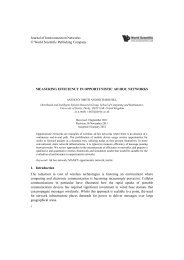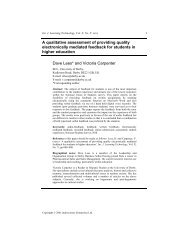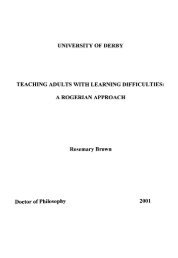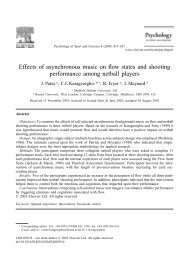- Page 1 and 2: UNIVERSITY OF DERBY }IN ON£IjfE Im
- Page 3 and 4: q>1i
- Page 5 and 6: q>IiCJJ fJliesis -.An Online In te{
- Page 7 and 8: (]J1i(]) q'fiesis - )In Onfine I nt
- Page 9 and 10: (]>/iCJJ q'fiesis -)In Onfine In te
- Page 11 and 12: (['tic[) tz1iesis -)In Onune I nte(
- Page 13 and 14: cpli(]) 'Iliesis - fln Onune I nte{
- Page 15 and 16: (]J1i(]) 'lliesis - jln Onfine I nt
- Page 17 and 18: q>IiCJJ q'fiesis - jln Onfine I nte
- Page 19: cpfiCJJ fJJiesis - )In OnCine I nte
- Page 23 and 24: (['Ii([) fJ1iesis - j'ln onCine Int
- Page 25 and 26: cpliq) fJ1iesis - )In Onfine I nter
- Page 27 and 28: q>1i(]) tfliesis - jIn Onfine I nte
- Page 29 and 30: cpliCJ) 'l1iesis -)f.n OnEine Inte{
- Page 31 and 32: PIiV lJ1iesis - )In Online I nte(fl
- Page 33 and 34: cpfzCJJ lJIiesis -)f.n online Inte(
- Page 35 and 36: fP/ilD lJIiesis - )In Onune I nteff
- Page 37 and 38: cpliCJJ q'fiesis - )1.n Onfine I nt
- Page 39 and 40: cpfz(]) 'lTiesis - jIn Onfine I nte
- Page 41 and 42: q>1i
- Page 43 and 44: cpfz(J) rzTiesis - )In Online I nte
- Page 45 and 46: cpli(]) rrFiesis - )In Onfine I nte
- Page 47 and 48: pli(]) 'lTiesis - )In OnCine I nte{
- Page 49 and 50: q>1i(]) q'/iesis - )1.n Onfine I nt
- Page 51 and 52: cpfz(J) fJliesis -)In Onfine Inte{{
- Page 53 and 54: pli(}) q'fiesis - )In Onfine I ntef
- Page 55 and 56: (JJ1i(]) rzTiesis - )In OnCine I nt
- Page 57 and 58: pfilD 11iesis - )In onfine Inte{[ig
- Page 59 and 60: cpliC]) 'lTiesis - )In Onfine I nte
- Page 61 and 62: cpfi fJ) rrTiesis - fin On(z'ne Int
- Page 63 and 64: Pfz(]) 'ITiesis -)In On fine Inte{{
- Page 65 and 66: Ph(]) Tfiesis -)In OnEine InteC[ioe
- Page 67 and 68: CP/ilJ) q'fzesis - )'In OnCine I nt
- Page 69 and 70: p fi(]) Tfiesis - )'l n On£i:ne I
- Page 71 and 72:
Pfi/l) 1Jiesis -}In onfine Inte{{if
- Page 73 and 74:
pfi(]) Tfiesis -)In On{£ne Inte[[i
- Page 75 and 76:
CPfi(j) 71iesis -)In Onfine Inte{{i
- Page 77 and 78:
Pfi/]) Tfiesis - )'In onfine Inte{[
- Page 79 and 80:
PlilD 71iesis -.JIll Olllille Itlte
- Page 81 and 82:
Pfz(j) rzTiesis - )In Online Inte{f
- Page 83 and 84:
cp/i/D fJ1iesis - jIn Onfine I nte{
- Page 85 and 86:
Ph/}) 7liesis -)In OnEine Inte[[lfj
- Page 87 and 88:
pli//) fJ1iesis - )In Online I ntef
- Page 89 and 90:
CPfifJ) rrFiesis -)In Onfine Inte[[
- Page 91 and 92:
Pfi/l) rrFiesis - .ft.n onfine Inte
- Page 93 and 94:
pfi(]) 1Jiesis - Jln Online Inte{[i
- Page 95 and 96:
P/i/!) rrTiesis - )In Onfine Inte[{
- Page 97 and 98:
Pfi([) Tfiesis - fln On fine I ntef
- Page 99 and 100:
PfiC[) TFiesis - )In OnEine Inteffi
- Page 101 and 102:
Pfi([) 7Tiesis - J2ln OnEine Inte({
- Page 103 and 104:
pfir[) 11iesis - An On{£ne I nte([
- Page 105 and 106:
Pfiq) Tfiesis - An OnCine Inteffige
- Page 107 and 108:
pfiq) Tfiesis - jln onfine Intef{ig
- Page 109 and 110:
pfi(j) rrFiesis - .fln OnEine Inte(
- Page 111 and 112:
Pfi(j) Tfiesis - A n Online Inte{[i
- Page 113 and 114:
(J'1i(]) f{fiesis - }In Onfine I nt
- Page 115 and 116:
Pfi
- Page 117 and 118:
cpfiq) 71iesis - )In On{£ne Inte{[
- Page 119 and 120:
Pfi([) Tliesis - fin OnEine Intelli
- Page 121 and 122:
Pfie]) 71iesis -}In OnCine Inte{[ig
- Page 123 and 124:
cp/im 71iesis - )1.n onfine Inte([i
- Page 125 and 126:
pfie]) 71iesis -;1.n onCine Inte{{i
- Page 127 and 128:
PIiC]) Tliesis - }In On£i:ne Intef
- Page 129 and 130:
Pfi/J) % esis - )'In onfine Inte{{i
- Page 131 and 132:
p fiCJ) 11iesis - .fin Online Intef
- Page 133 and 134:
p fiCfJ 7hesis - )In Online Inte[[i
- Page 135 and 136:
Pfi/D Tfiesis - An Onfine InteffifJ
- Page 137 and 138:
cpfi/D Tfiesis - )In Onfine I nteC[
- Page 139 and 140:
pfi(j) Tfiesis - }1.n On fine Inte{
- Page 141 and 142:
PIiCD %esis - fin On[ine Intef[igen
- Page 143 and 144:
pfi(j) Tfiesis - j'ln Onfine Inteff
- Page 145 and 146:
Pfz(J) 7Tiesis - )'In On fine Intef
- Page 147 and 148:
Pfz([) 'lIiesis - )In Onfine I nte{
- Page 149 and 150:
PIi([) rrFiesis - An Onane Intef[ig
- Page 151 and 152:
pli(]) TFiesis - }l.n OnEine Inte£
- Page 153 and 154:
Pfi
- Page 155 and 156:
PfiC]) 71iesis - )In OnEne Intef[ig
- Page 157 and 158:
80 ~------------___________________
- Page 159 and 160:
pfiq) Tfiesis - Jln Onfz'ne Inte[{i
- Page 161 and 162:
cpf"m 'Iliesis -./In Online Intelr'
- Page 163 and 164:
P/i(]) 7'fiesis - }In Onune Intef[i
- Page 165 and 166:
pli
- Page 167 and 168:
pfie]) 'ITiesis - )In Onune Inte({i
- Page 169 and 170:
pli(]) T1iesis - )In Onfine Intef{i
- Page 171 and 172:
pfie]) Tfiesis - fln Onfine I nte{{
- Page 173:
cpfi
- Page 176 and 177:
cpfiq) Tfiesis - )In Online InteCfi
- Page 178 and 179:
p fi(]) 'Tfiesis - }1.n OnEine I nt
- Page 180 and 181:
cpfiCD Tfiesis - J1.n OnEine Inte[{
- Page 182 and 183:
CPfiCD Tfzesis - )In Onfine I nte{[
- Page 184 and 185:
(]J/i/J) rzTiesis - )In Online I nt
- Page 186 and 187:
cpfi(]) 'lTiesis - J/.n Onfine I nt
- Page 188 and 189:
PfiCD 1Jiesis - )In Onfine Intef[ig
- Page 190 and 191:
pfi(]) 1Jiesis -.fln Onfine Inteffi
- Page 192 and 193:
PfiCJJ 7Jiesis - )In Onfine Inte{[i
- Page 194 and 195:
fPIi
- Page 196 and 197:
pli(]) 11iesis - )In Onfine Intef{i
- Page 198 and 199:
CPfz(j) % esis - An Onfine Inte{{ig
- Page 200 and 201:
pfi/J) 'ITiesis - JIn Onfine Inteff
- Page 202 and 203:
PIi(]) 1Tiesis - An Online Inte{{ia
- Page 204 and 205:
pli(]) rrliesis - }In Onfine Inteff
- Page 206 and 207:
6 ~----____________________________
- Page 208 and 209:
pfi(j) 71iesis - JLn Onfine I nteff
- Page 210 and 211:
ph/I> 7liesis - An OnEine Intef{ige
- Page 212 and 213:
pfi(]) 71iesis - J1.n Online Intef{
- Page 214 and 215:
pfz(j) 71iesis - An OnCine InteHige
- Page 216 and 217:
Pfi(]) 7Tiesis - )In Onfine Inteffi
- Page 218 and 219:
(['1i
- Page 220 and 221:
cpli(]) Tliesis - )In Onfine I ntef
- Page 222 and 223:
(J'/i
- Page 224 and 225:
q>/i(]) Tfiesis - }f.n OnCine I nte
- Page 226:
CP/i(]) 'lIiesis - An Onfine InteCf
- Page 229 and 230:
cplil[) rrtiesis - )'In Online I nt
- Page 231 and 232:
fP/iCJJ %esis -)In Online I nte{fze
- Page 233 and 234:
PFiCD TFiesis - Jln OnCine Inte{fig
- Page 235 and 236:
tl'IiCD tfliesis - )In OnCine I nte
- Page 237 and 238:
(J'1i(]) 'l1iesis - )In Onfine I nt
- Page 239 and 240:
([Jfi(]) t[fiesis - An Onfine Inte{
- Page 241 and 242:
pfiCD 7Tiesis - )In Onfine Inteffig
- Page 243 and 244:
~IiCJJ 71iesis - )In OnCine I nte{f
- Page 245 and 246:
fPliCD tzTiesis - )In OnCine I nte{
- Page 247 and 248:
tpfiV 'Tfiesis -.fl.n Onfine I nte{
- Page 249 and 250:
~fzCD 'lliesis -)lln Onfine I nte([
- Page 251 and 252:
(['1i
- Page 253 and 254:
~fi
- Page 255 and 256:
cpfi(/) 71iesis -}In Onfine Inte{{i
- Page 257 and 258:
cpfi(]) 71iesis -}In Onfine Inteffi
- Page 259 and 260:
q>IiCD Tfiesis - Jln OnEine InterHg
- Page 261 and 262:
q>1iCJ) 'lJiesis -)1.n Onfine Inte{
- Page 263 and 264:
cpfiCD Tfiesis - }In OnEine I ntefE
- Page 265 and 266:
cpfz(j) TFiesis - }In OnEine Inte[{
- Page 267 and 268:
PIirJ) Tliesis - }In Onfine I ntef{
- Page 269 and 270:
Pfi(/) %esis - fin Onfine I ntef(ig
- Page 271 and 272:
(]?Ii(]) 71iesis - An Onfine Inte{[
- Page 273 and 274:
CPfi(]) 7Tiesis - fln OnEine I ntef
- Page 275 and 276:
q>/im 7liesis - }In Onfine Inteffig
- Page 277 and 278:
q>/i/D tzTiesis - )In OnCine I ntef
- Page 279 and 280:
pfi/D 71iesis - Jln OnEine I nte[Ei
- Page 281 and 282:
q>/i/J) rrFiesis - )In Onftne I nte
- Page 283 and 284:
pfiCD %esis - )In Online Intefligen
- Page 285 and 286:
(]JIiCD rrFiesis - )In OnCine I nte
- Page 288 and 289:
pliCf) TFiesis -)'In OnEine InterEi
- Page 290 and 291:
pfi(j) %esis - )In Onfine I ntef{ig
- Page 293 and 294:
cpfi(]) 'TTiesis - JLn OnEine Intef
- Page 295 and 296:
(J'IiCD tf/iesis - )'In Onfine I nt


![(])octor of Plii{osopliy - University of Derby Online Research Archive](https://img.yumpu.com/39228394/20/500x640/octor-of-pliiosopliy-university-of-derby-online-research-archive.jpg)








